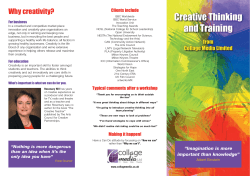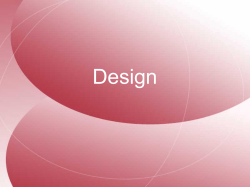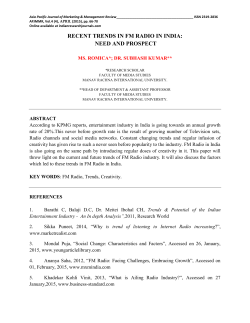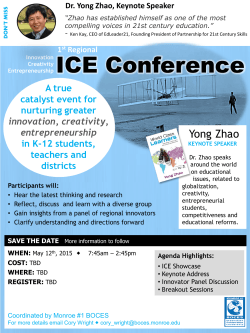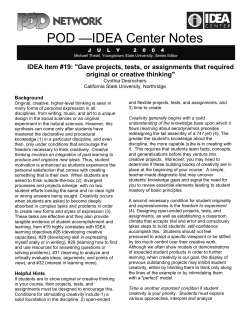
An Examination of the Intermediary Role of Creativity in the Relation
© 2015, ISSN: 2322-4770 Science-Line Publication Journal of Educational and Management Studies www.science-line.com J. Educ. Manage. Stud., 5(1): 27-33, March 25, 2015 JEMS An Examination of the Intermediary Role of Creativity in the Relation between Knowledge Management and Faculty Members (Case Study: Tehran's Azad University's units, Iran) 1* 2 Saba Shaterani , Fariba Gheytasi Zadeh , Farkhonde Goodarzi 3 1 Department of Educational Management, College of Educational Science and Consultation, Roudehen Branch, Islamic Azad University, Roudehen, Iran 2 Master of Educational Science (curriculum) Payam e Noor University of Tehran, Iran 3 Master of Educational Administration Allameh Tabatabaei Teacher of Elmikarbordi University, Iran *Corresponding author's Email: sabashaterani@hotmail.com ORIGINAL ARTICLE INTRODUCTION PII: S232247701500006-5 Received 12 Jan. 2015 Accepted 05 Mar. 2015 ABSTRACT: The purpose of the present study was to examine the effect of knowledge management on the performance of faculty members, with an emphasis on their intermediary role of creativity. This study was practical in terms of purpose, descriptive-survey research in terms of method of obtaining data and quantitative in terms of the type of the collected data (the use of questionnaires). The statistical population of the study consisted of the faculty members of Tehran's Azad University's Units (2200 members), which 327 of them were selected as the sample size, using the Cochran Formula. Having used the Stratified Random Sampling method, the questionnaires were handed to the respondents in the statistical sample. The analysis of the data was done using the Structural Equation Modeling method (SEM) and the PLS software. The results of the study demonstrated the positive and significant effect of knowledge management on the performance of the studied faculty members and the significance of the intermediary role of creativity. Key words: Employees’ Performance, Knowledge Management, Creativity, Faculty Members. organizations which wish to be a learning-based organization. Thus, to survive progress and maintain current conditions, it is important to sustain knowledge and innovation in the society in order to prevent inaction; therefore there is a need for educational institutions with creative staff. Universities must be able to provide the society with growth and development in the direction of globalization. This can provide sustainable competitive advantages, due to the fact that the knowledge produced in a country's research and development centers such as universities cannot easily be copied by regional rivals (Audretsch, 2014). Without having universities possessing effective scientific elements, creative activities in the society are not expected (Zeichner, 2010); also, knowledge and training cannot spread in the society and people cannot use them to improve their own performance. Without the presence of creative academics, knowledge management cannot enhance the performance of the society and universities. If academics do not encourage the sharing and distribution of knowledge, knowledge management faces challenges in the entire society (Bathelt et al., 2010). The examination of the current conditions of universities shows that there are numerous difficulties in the process of providing a proper atmosphere for creative thinking, innovativeness, and learning skills. Hence it is necessary to investigate how the performance of faculty members can be enhanced and what factors can affect this in organizations. Undoubtedly, different factors influence the performance of university professors; in the present Today, universities, as micro-systems in societies, play an important role in the process of development. If we consider development components in political, social, cultural, economic, and educational dimensions, the influence of universities can't be ignored (Gunasekara, 2006). Hence these centers, which make development possible and are the drive of all the development dimensions, need to develop themselves internally. In the process of universities' internal development, it is necessary to pay attention to subjects such as knowledge, performance and creativity of employees. Since one of the most crucial features of educational systems such as universities is the need for the use of new thoughts in order to make management processes efficient (Muller-Chris, 2014), the importance of universities is increasingly paid attention to. Regarding creativity, it must be said that any organization should possess creative staff to be able to maintain its effectiveness and dynamism in a tough environment which requires profession creativity (Naderi et al., 2009). The employees' creativity is influenced by various factors; one of these factors is knowledge management. In recent years, organizations have started to join the knowledge procedure. Knowledge is considered as a key source for creativity and innovation, which must be managed (Hamis et al., 2013). Therefore, only those organizations which are able to use their knowledge as a sustainable competitive advantage can have a successful performance. Hence knowledge management has become an important duty in To cite this paper: Shaterani S, Gheytasi Zadeh F, Goodarzi F. 2015. An Examination of the Intermediary Role of Creativity in the Relation between Knowledge Management and Faculty Members (Case Study: Tehran's Azad University's units, Iran). J. Educ. Manage. Stud., 5 (1): 27-33. 27 Shaterani et al., 2015 study, according to the main purpose, two variables – knowledge management and creativity – are discussed. system. In line with this, scholars refer to "organizational memory" which is the ability to maintain knowledge. 3. Converting and transferring knowledge: refers to activities including the translation, conversion, interpretation and purification of knowledge. 4. Applying knowledge: includes activities which are related to the implementation of knowledge in organizational processes (Newman & Conrad, 2000). Performance is a criterion for the measurement and determination of organizational effectiveness in a certain period, which is characterized by certain signs in the market, customers and sales (Adams and Sykes, 2003). Measuring performance contributes to managers in decision-making processes, and also makes it possible for them to effectively control and monitor organizational activities (Azevedo et al, 2011). The main challenge for researchers in the process of studying and examining real conditions of organizations is the analysis of performance. The complexity of performance analysis is because there are different organizational players such as supplier, producer, retailer and customers (Deshpande, 2012). In today's competitive world, efficiency has improved in all areas and only those organizations which exploit their sources in the best possible way can survive and perform efficiently; therefore, performance improvement which enhances the efficiency of human resources is of great importance. Today, in modern and developed organizations, the most important factor which determines their status is their performance (Acquaah, 2007). Performance consists of different dimensions; the performance of human resources is one of the most important dimensions. The importance of evaluating the performance of employees and valuating their work and services in order to recognize their weaknesses and strengths has always been known to managers. Hence in most countries' organizational systems, the evaluation results are considered as the base of making important organizational decisions; and the results are examined, considering inadequacies in employees' performance (Bapna et al, 2013). Therefore, efficient and skillful employees can make the environment efficient and profitable, leading to success in countries. In underdeveloped countries, most organizations have inefficient employees who inevitably cause organizational costs (December et al, 2012). The performance of employees is used as a tool for controlling the quality of human resources management measures. The existence of a large A review of the literature Nowadays, intense competition in different areas has urged large and small organizations to implement knowledge management. Knowledge management is a process which helps organizations collect, select, organize and publish important information; it's also an expertise which is necessary for activities such as problem-solving, dynamic learning, and inference (Davenport, 1997). Knowledge management can improve organizational performance by making it possible for organizations to perform more intelligently. Knowledge management is the process of changing data to information and then changing information to knowledge (Vaccaro et al, 2010, Gottschalk, 2007). (Gloet & Terziovski 2004) have defined knowledge management as access to experience, knowledge and expertise, which provides new capabilities, encourages innovation, and increases the value of customers. Generally, knowledge management and areas related to it emphasize the fact that, in the new global economic atmosphere, sustainable competitive advantage can occur according to organizations' ability and capacity to develop and make appropriate use of their knowledge-based sources (Joo and Lee, 2009). Newman and Conrad (2000) state that, within these processes, data are changed to information, information is changed to knowledge and finally initial knowledge is changed to ultra-knowledge. They find this process similar to a life cycle; and they consider four stages for this cycle (Figure1): Figure 1. The general model of knowledge management, source [Newman and Conrad, 2000] 1. Creating knowledge: This stage consists of activities which are related to the entrance of new knowledge into the system, including the discovery, capturing and development of knowledge. 2. Retaining knowledge: This stage consists of activities that help to sustain the knowledge in the 28 J. Educ. Manage. Stud., 5(1): 27-33, 2015 number of employees with low levels of performance can indicate that there are problems in performing one of the human resources management tasks (Robertson et al, 2012). The results obtained from the evaluation of employees can be used in order to ensure that other human force management tasks are done; here, the importance of studying and examining employees' performance is characterized. Christ et al. (2012), the most important advantage of evaluating the performance of employees is that employees can be assigned to different responsibilities in accordance with their skills, interests, etc. Therefore, each employee is expected to perform according to his/her capabilities. Luthans et al. (2008), believe that, in order to make an efficient use of human force and reduce costs, managers should discover the causes of poor performance in employees by studying and analyzing their working conditions. In previous studies, employees' performance is one of the examined dimensions. Some researchers have referred to employees' knowledge and skills, and some other have referred to the communicational and team work skills in employees. One of the "employee-performance" studies which has been accepted by many scholars is the study done by Koopman et al. (2002); his study classifies the performance of employees in five components: 1. Having knowledge about their job, 2. Cooperation and coordination with other employees, 3. Career scheduling, 4. Proper interaction with superiors, and finally, 5. Organizational culture. In terms of performance, the role of efficient employees in universities, as organizations which give services to the society, is very crucial. Since universities have an increasing number of rivals, they pay more attention to the evaluation and improvement of human force in order to enhance their competitive advantage, compared to other educational organizations and institutions. Today, creativity is an important part of organizational life, because drastic global changes in all aspects have revolutionized organizational activities so greatly that managers have to find new ways to adapt to global changes and evolutions. Creativity is defined as the ability to find new things which are useful for a certain period (Woerkum and Aarts, 2007). Mikulincer & Shaver, (2005), define creativity as one's ability to produce thoughts, insights, and the ability to take new and effective actions which have high social, economic and scientific practicality (Castiglione, 2008). In fact, creativity is the interaction between talent, process and environment, with which individuals or groups produce a new, practical and understandable product as a defined social context (Makel and Plucker, 2008). Torrance, (1972) believes that creativity consists of four dimensions: fluency (the ability to have a significant relation between mind, thoughts and expression); originality (the ability to think in an unusual way); flexibility (the ability to think in different ways to solve problems); elaboration (the ability to notice details while doing an activity). The relation of creativity with performance variables, knowledge management and other organizational variables such as leadership style, organizational structure, job satisfaction, efficiency, organizational commitment, etc. has been the focus of many studies. However, not many studies have focused on the simultaneous effect of knowledge management variables, employees' creativity and performance; this shows the importance of the present study. Considering the literature, the following hypotheses were suggested which, according to the study's conceptual model (2), are as follows: Main hypothesis (Ha): knowledge management has a positive impact on the performance of universities' faculty members. Subsidiary hypothesis 1 (Hb1): knowledge management has a positive effect on the creativity of faculty members. Subsidiary hypothesis 2 (Hb2): Faculty members' creativity has a positive effect on their performance. H b1 Knowledge management Creating knowledge Retaining knowledge Converting and transferring knowledge Creativity Fluency Flexibility Originality Elaboration H b2 Employees' performance Job knowledge H a Cooperation and coordination Job scheduling Proper interaction with managers Figure 2. Conceptual model of the study Applying Compatibil knowledge ity with METHODOLOGY organizatio nal culture The method used in this study, in terms of purpose, is a practical study; it, in terms of the method of obtaining data, is a descriptivecorrelational research; and it, in terms of the type of 29 Shaterani et al., 2015 the collected data, is a quantitative research (the use of questionnaires). In order to receive comments from the studied universities' faculty members, questionnaires were given, and the results have been obtained. The structural equation modeling method was used to examine the conceptual model and the hypotheses. Using this method, on the one hand, it is possible to measure the accuracy of indexes and/or the observable variables; on the other hand, it is possible to examine the excellent relation between hidden variables and the level of the expressed variance (Byrne, 2013). The statistical population of this study consists of the faculty members of Tehran's Azad university's units (including 2200 members). 327 members were selected as the sample size using the Cochran formula. The questionnaires were given to the respondents of the statistical sample, using the stratified random sampling method and considering the number of people in each stratification. Initially, Tehran's Azad university units included five stratifications: the south of Tehran, the east of Tehran, the north of Tehran, the west of Tehran and the center of Tehran. From each stratification, professors were selected randomly, and received questionnaires. In addition, in order to collect data, the research done by Koopman et al. (2002), was used to evaluate employees' performance, the standard Torrance questionnaire (1972) was used to evaluate creativity, and the standard Darroch questionnaire (2003) was used to evaluate knowledge management. Using the data obtained from the questionnaires and the PLS statistical software, the reliability of the questionnaires was calculated using the Cronbach's Alpha method and combinational reliability. Considering the fact that 0.7 about these two criterion shows acceptable reliability (Hollan, 1999), the results related to these two criterion are given in the table below; as it can be seen, all reliabilities are higher than 0.7, which shows the proper reliability of the questionnaire: Table 10. Investigation of the reliability of the questionnaire Creating knowledge Elaboration with details originality flexibility fluency Compatibility with culture Proper interaction with managers Job scheduling Cooperation and coordination Job knowledge variables Retaining knowledge Employees' performance Transferring knowledge creativity Applying knowledge Knowledge management Dimensions of variables 0.76 0.75 0.75 0.72 0.80 0.81 0.79 0.84 0.80 0.81 0.76 0.76 0.74 Cronbach’ s alpha 0.84 0.80 0.80 0.78 0.88 0.89 0.88 0.91 0.85 0.86 0.82 0.83 0.81 Combinational variable 0.66 0.70 0.72 0.73 0.65 0.71 0.66 0.68 0.60 0.59 0.55 0.62 0.56 AVE Table 2. Examination of the questionnaire's divergent validity variables Knowledge management Knowledge management 0.82 creativity 0.34 0.88 Employees' performance 0.17 0.25 The validity of the questionnaire was examined using two criterions: convergent validity and divergent validity. In the convergent validity section, the AVE criterion (the extracted variance mean) was used; the results of this criterion for the variables of the study are given in the table above. The acceptable validity for AVE, is 0.5 (Hulland, 1999). As it can be seen from the table above, all the values of AVE were greater than 0.5; this shows that the creativity Employees' performance 0.76 convergent validity of the questionnaire is acceptable. In the divergent section, the comparison of the AVE square of the main variables with correlation coefficient values between them was examined. The values in the main diagonal of this table are the square of the variables' AVE coefficients; and the values below and above the main diagonal are the correlation coefficients between each variable and other variables. 30 J. Educ. Manage. Stud., 5(1): 27-33, 2015 As it can be seen from the matrix, each variable's AVE square (the value of the main diagonal) is greater than the correlation variables of that variable with other variables (variables in the same line and column). This shows the acceptability of the questionnaire's divergent validity. management on the performance of faculty members with a causal coefficient of 0.71 is significant and positive (approving the main hypothesis). In addition, knowledge management has a positive 46% effect on the creativity of faculty members (approving subsidiary hypothesis 1), and also creativity has a positive, significant 49% effect on the performance of faculty members (approving subsidiary hypothesis 2), which shows the significance of the intermediary role of creativity. The causal coefficient presented in the figure below show the level of the variables' effects on one another. As it can be seen, all the relations in 95% and 99% confidence have been significant. RESULTS The cause and effect relation of knowledge management with faculty members and also the intermediary role of creativity have been evaluated. As shown in tables 2 and 3, the impact of knowledge Elaboration to details Originality Flexibility 0.68 0.6 0.7 Fluency 0.5 Creativity Creating knowledge Retaining knowledge Knowledge transfer 0.8 0.6 0.7 Job knowledge 04.0* 04.0* 0.6 Cooperation 0.7 Knowledge management ** 0.71 0.7 Employees' performance 0.7 0.7 0.7 Applying knowledge Scheduling Proper interactions Compatibility with culture Figure 3. Implementation of the study's model, using the PLS software DISCUSSION AND CONCLUSION With the approval of the main hypothesis, it was shown that knowledge management has had a positive and significant effect on the creativity of the studied professors. The review of the literature showed that in previous studies, knowledge management plays an important role in the improvement of people's performance by providing a useful and valuable culture and also providing a cooperation culture in organizations. Researchers have emphasized the crucial role of knowledge management in providing an internal working environment which supports creativity and innovation. Previous studies, which have referred to the positive and significant relation between knowledge management and creativity and innovation in organizations, approve the finding of the present study. As mentioned, countries, especially developing countries such as Iran, need human resources possessing high levels of performance in order to maintain their existence and compete in today's world in hope of future advances. It's by having these human resources that a country can adapt to new conditions and progress while facing global challenges. Different factors affecting people's performance were mentioned. In the present study, we examined the effect of creativity and knowledge management in Iran's academic society. The results of the study showed that these two variables have a positive, significant effect on the performance of the studied university faculty members. 31 Shaterani et al., 2015 The results obtained from the subsidiary hypothesis 1 show the positive and significant effect of knowledge management on the creativity of studied professors. Previous studies have emphasized that knowledge management, as a key factor, plays an effective role in providing a creative and innovative atmosphere in organizational employees. In conclusion, much attention should be paid to the correct implementation of knowledge management in order to provide a creative and innovative atmosphere. Certain studies have been conducted which consider the correct implementation of knowledge management in organizations as the key to a creative environment; this environment makes it possible for people to express their ideas, leading to better performance. Hence, the results of subsidiary hypothesis 1 are in line with the results of the previous studies. The results obtained from the study's subsidiary hypothesis show that the creativity of university professors has a positive and significant effect on their performance. With a review of the literature, it can be said that, in previous studies, creativity plays an important role in the improvement of employees and organizations' performance by offering new strategies and solutions to organizational problems. Researchers have emphasized the key role creativity and innovation in the improvement of performance, which approves the fact that their results are in line with the present study. Motivation*.Contemporary Accounting Research, 29(2), 432-452. Darroch, J. (2003). Developing a measure of knowledge management behaviors and practices. Journal of knowledge management, 7(5), 41-54. Davenport, T. (1997), "Ten principle of km". Knowledge and process management, 4(3), 149-158. Decramer, A., Smolders, C., Vanderstraeten, A., & Christiaens, J. (2012). The impact of institutional pressures on employee performance management systems in higher education in the low countries. British Journal of Management, 23(S1), S88-S103. Denison, D. R. (2000). Organizational culture: Can it be a key lever for driving organizational change. In S. Cartwright & C. Cooper (Eds.), the handbook of organizational culture. London: John Wiley & Sons. Gloet, M., Terziovski, M. (2004), "Exploring the Relationship Between Knowledge Management Practices and Innovation Performance", Journal of Manufacturing Technology Management, 15(5), 402-9. Gottschalk, P. (2007), "Sharing Knowledge in law Firms", Journal of Innovation and Learning, 4(3), 255-73. Gunasekara, C. (2006). Reframing the role of universities in the development of regional innovation systems. The Journal of Technology Transfer, 31(1), 101-113. Harris, R., McAdam, R., McCausland, I., & Reid, R. (2013). Knowledge management as a source of innovation and competitive advantage for SMEs in peripheral regions. The International Journal of Entrepreneurship and Innovation, 14(1), 49-61. Hinkelman, E. G. & Genzberger, C. (2008). "The Relationship between Organizational Culture and Knowledge Management (Case study at the University of Hamburg)", Word Trade Press, January. Hirsh, A & Smircich, L (2009). Leadership: The management of meaning 4 Journal of Applied Behavioral science, pp. 114-1124 Hulland, J4 (1000)4 ‘Use of partial least squares (PLS) in strategic management research: A review of four recent studies. Strategic Management Journal, 20(2), Pp:195–204. Joo, J; Lee, S. M. (2009). "Adoption of the Semantic Web for overcoming technical limitations of knowledge management systems", Journal of Expert Systems with Applications, 36, 7318–7327. Koopman, C., Pelletier, K. R., Murray, J. F., Sharda, C. E., Berger, M. L., Turpin, R. S., & Bendel, T. (2002). Stanford presenteeism scale: health status and employee performance. Journal of Occupational and Environmental Medicine, 44(1), 14-20. REFERENCES Audretsch, D. B. (2014). From the entrepreneurial university to the university for the entrepreneurial society. The Journal of Technology Transfer, 39(3), 313-321. Bapna, R., Langer, N., Mehra, A., Gopal, R., & Gupta, A. (2013). Human capital investments and employee performance: an analysis of IT services industry. Management Science, 59(3), 641-658. Bathelt, H., Kogler, D. F., & Munro, A. K. (2010). A knowledge-based typology of university spin-offs in the context of regional economic development. Technovation, 30(9), 519-532. Byrne, B. M. (2013). Structural equation modeling with AMOS: Basic concepts, applications, and programming. Routledge. Castiglione, J.(2008). Facilitating employee creativity in the library environment: An important managerial concern for library administrators. Library management, 29, 35-52. Christ, M. H., Emett, S. A., Summers, S. L., & Wood, D. A. (2012). The Effects of Preventive and Detective Controls on Employee Performance and 32 J. Educ. Manage. Stud., 5(1): 27-33, 2015 Luthans, F., Norman, S. M., Avolio, B. J., & Avey, J. B. (2008). The mediating role of psychological capital in the supportive organizational climate— employee performance relationship. Journal of organizational behavior, 29(2), 219-238. Makel, M., and Plucker, J. (2008). Handbook of Giftedness in Children. pp:247-270. Müller-Christ, G., Sterling, S., van Dam-Mieras, R., Adomßent, M., Fischer, D., & Rieckmann, M. (2014). The role of campus, curriculum, and community in higher education for sustainable development–a conference report. Journal of Cleaner Production, 62, 134-137. Naderi, H., Abdullah, R., Aizan, H. T., Sharir, J., & Kumar, V. (2009). Creativity, age and gender as predictors of academic achievement among undergraduate students. Journal of American Science, 5(5), 101-112. Newman, B. B; Conrad, K. W. (2000). "A Framework for Characterizing Knowledge Management Methods, Practice, and Technologies, in: Proceedings of the Practical Aspects of Knowledge Management” (PAKM 2000), The Knowledge Management Forum, 16-33. Robertson, I. T., Birch, A. J., & Cooper, C. L. (2012). Job and work attitudes, engagement and employee performance: Where does psychological wellbeing fit in?. Leadership & Organization Development Journal, 33(3), 224-232. Torrance, E. (1972). Predictive Validity of the Torrance Tests of Creative Thinking*. The Journal of Creative Behavior, 6(4), 236-262. Vaccaro, A., Parente, R., Veloso, F.M. (2010), "Knowledge Management Tools, Interorganizational Relationships, Innovation and Firm Performance", Technological Forecasting & Social Change, 32, 34-20. Wang, D., Su, Z & ,4Yang, D4 (2011) Organizational culture and knowledge creation capability, Journal of knowledge management, 15(3), 363-373. Woerkum, C.M.J. van and Aarts, M.N.C (2007). Creativity, planning and organizational change. Journal of Organizational Change Management. 20(6), 847-865. Zeichner, K. (2010). Rethinking the connections between campus courses and field experiences in college-and university-based teacher education. Journal of teacher education, 61(1-2), 89-99. 33
© Copyright 2025



